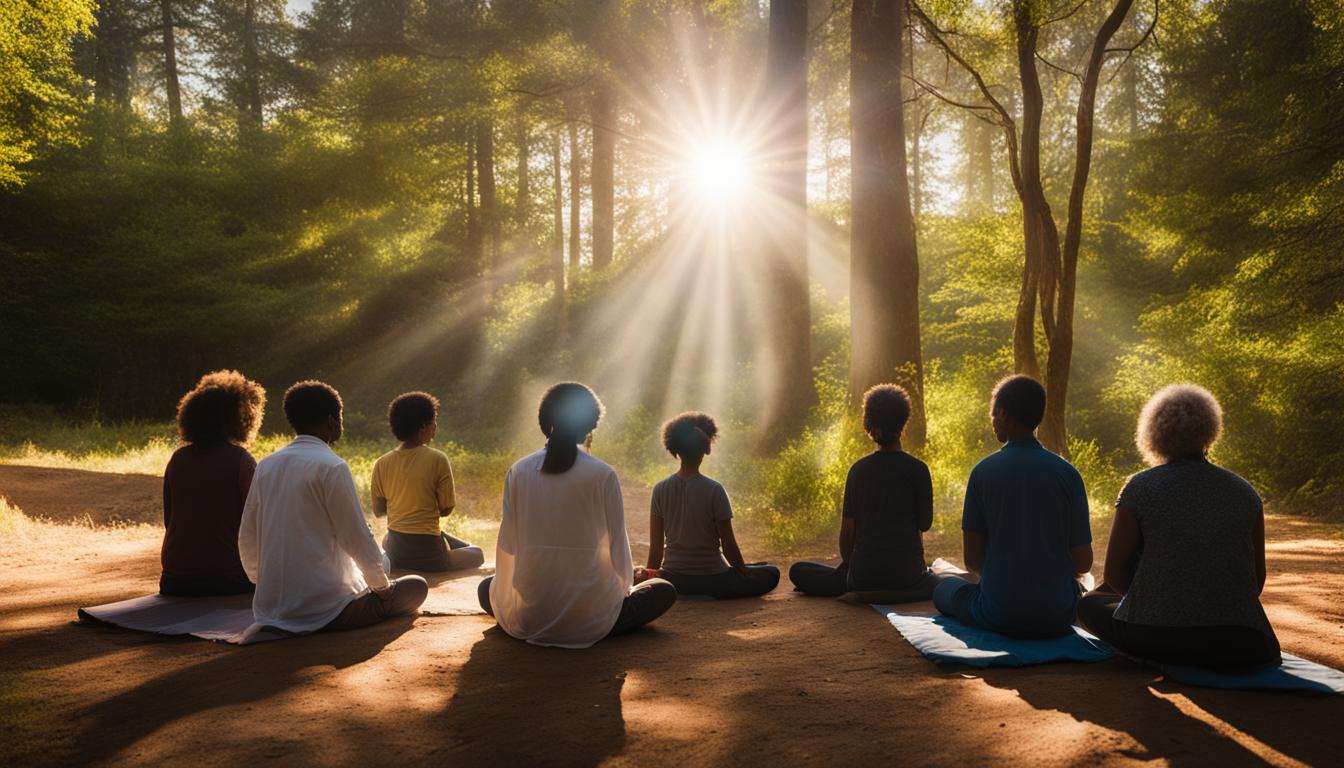Disclosure: This Post Contains Affiliate Links; We earn a commission on purchases.
Restlessness is a common challenge that many beginners face during meditation. It can manifest as a mind that won’t quiet down, a constant feeling of need to move, or impatience with the meditation process. Understanding restlessness and its role in the meditation journey is the first step towards managing it effectively.
Restlessness during meditation is not a sign of failure, but rather an opportunity for growth and deeper self-discovery. It is a natural part of the purification and release process that meditation induces in the mind and body. By peeling off the layers of thoughts and distractions, restlessness is an indication that progress is being made. It is important to recognize that having thoughts during meditation does not mean that one is not in a deep state of rest. The key is to refocus the attention on the intended object of meditation, such as the breath or a mantra, whenever the mind wanders.
Restlessness in meditation can also mirror restlessness in one’s daily life, highlighting the need for balance and harmony. Taking steps to create a more peaceful and structured lifestyle can support the meditation practice. With patience and commitment, restlessness can be managed and transformed into a source of strength and insight.
Key Takeaways:
- Restlessness in meditation is a common challenge faced by beginners.
- Understanding restlessness is the first step towards managing it effectively.
- Having thoughts during meditation doesn’t mean one is not in a deep state of rest.
- Creating a structured and peaceful lifestyle can support the meditation practice.
- With patience and commitment, restlessness can be transformed into a source of strength and insight.
Understanding Restlessness and Impatience in Meditation
Restlessness and impatience are two common experiences that can arise during meditation. They are integral parts of the meditation process and play a significant role in one’s journey towards inner peace and self-discovery.
During meditation, there are three basic types of experiences that can occur:
- Falling Asleep: Sometimes, the mind and body can become so relaxed during meditation that you may find yourself drifting off to sleep. This is a natural response and indicates the deep relaxation achieved through your practice.
- Thoughts and Restlessness: It is normal to have thoughts and feel restless during meditation. These experiences are not obstacles but rather indications that your mind and body are releasing and purifying. Restlessness can often reflect the busyness and tiredness of your daily life.
- Slipping into Silence: Occasionally, you may experience moments of slipping into silence, where your thoughts subside, and you connect with a field of silence and infinite possibilities. These moments are precious and offer glimpses of the true essence of meditation.
By recognizing and understanding these different experiences, you can navigate the challenges of restlessness and impatience with greater ease. It is essential to let go of the need to analyze or judge your meditation experiences. Instead, focus on cultivating mindfulness and embracing the present moment.
“Do not strive for specific experiences during meditation. Instead, aim to enrich your everyday life and cultivate a shift in awareness that extends beyond your meditation practice.”
Restlessness and impatience in meditation are not obstacles to be eliminated but rather signs of progress and growth. They provide an opportunity for self-reflection and offer insights into the interconnectedness of your thoughts, emotions, and daily activities.
Restlessness can also be an invitation to examine your lifestyle and create balance and harmony. By making conscious choices to slow down and simplify your life, you can support your meditation practice and minimize restlessness.
Remember, meditation is not about achieving a specific state of mind or suppressing restlessness. It is a journey of self-discovery and acceptance. Embrace the restlessness, observe it without judgment, and trust that with patience and commitment, you will find peace and clarity in your meditation practice.
Tips for Managing Restlessness and Impatience in Meditation
For beginners, restlessness and impatience can often hinder the meditation experience. However, with the right strategies, these challenges can be effectively managed and overcome. Here are some practical tips to help you find greater peace and focus during your meditation sessions:
- Prepare Your Meditation Space: Find a quiet and comfortable space where you can meditate without distractions. Switch off your phone, and let others in your household know not to disturb you during this time.
- Stretch and Release Tension: Prior to starting your meditation, gently stretch your body to release any physical tension. This can help prepare your body for stillness and relaxation.
- Take Deep Breaths: Before you begin your meditation, take a few deep breaths to calm your mind and shift your focus away from unnecessary distractions. Deep breaths can help you enter a state of relaxation and mental clarity.
- Centering Exercise: Try a centering exercise to bring your mind and body into alignment. Place one hand over your navel and raise the other arm, taking deep breaths. This exercise can help you connect with your energetic field and promote a sense of grounding.
- Alternative Nostril Breathing: Settle your mind and body by practicing alternative nostril breathing. Inhale and exhale through one nostril at a time, using your thumb and ring finger to alternate nostrils. This technique can help create a state of balance and relaxation.
- Commit to a Meditation Routine: Establishing a regular meditation routine is key to cultivating consistency and discipline in your practice. Set a predetermined duration for your meditation sessions and commit to sticking to it. This will help you build a strong foundation for your meditation practice.
By implementing these tips, you can create a supportive environment for your meditation and develop effective strategies to manage restlessness and impatience. Remember to be patient and compassionate with yourself as you navigate the challenges of meditation. With time and practice, you will be able to find greater peace, focus, and inner clarity.
“The mind is restless, turbulent, obstinate and very strong, O Krishna, and to subdue it, I think, is more difficult than controlling the wind.” – Bhagavad Gita
Meditation as a Reflection of Your Life
The meditation journey is often a reflection of one’s life. If daily life is busy and chaotic, it is natural for the meditation practice to mirror this restlessness. It is important to remember the story of the tortoise and the hare and embrace the value of slowing down. By adopting a more measured and balanced approach to life, the meditation experience can become more peaceful and harmonious.
Finding stillness in meditation is not about suppressing or eliminating restlessness, but rather creating space for it and observing it without judgment. Just like in life, restlessness is a part of the meditation process. Instead of resisting or reacting to restlessness, the meditation practice offers an opportunity to cultivate patience and acceptance.
“In meditation, we learn to sit with discomfort and restlessness, allowing them to arise and pass without getting caught up in them. This teaches us the skill of patience and resilience.”
Patience is a key virtue in meditation. It is natural to desire quick progress and immediate results, but true transformation takes time. By practicing patience and accepting the present moment as it is, the rewards of meditation can unfold gradually and lead to lasting inner peace and clarity.
Creating balance between meditation and daily life is crucial. Just as meditation requires stillness and focus, so does finding balance in one’s lifestyle. Slowing down in meditation can inspire us to slow down in other aspects of our lives. By making conscious choices to prioritize self-care, set boundaries, and create moments of stillness throughout the day, we can support our meditation practice and cultivate a greater sense of peace and fulfillment.
Remember, meditation is not a race or a competition. Each person’s meditation journey is unique, and progress is not measured by the ability to sit in complete stillness for extended periods of time. The value of meditation lies in the process itself, the self-awareness it cultivates, and the insights it brings. Embrace the reflection of your life within your meditation practice, and let patience guide you towards a deeper connection with yourself and the world around you.
Overcoming Restlessness in Meditation
If you’re a beginner struggling with restlessness during meditation, don’t worry. There are effective strategies that can help you overcome this common challenge. Let’s explore some techniques that can help you manage and transform restlessness into a source of strength and insight.
- Cultivate curiosity about restlessness: Instead of reacting impulsively to restlessness, pause and observe the sensations in your body that correlate with the feeling of restlessness. By cultivating curiosity, you can create distance and reduce the intensity of restlessness.
- Change your meditation focus: Shift your attention away from the restlessness and towards the feeling of your whole body sitting and the sounds in the environment. Expanding your field of attention can create a sense of spaciousness and reduce the dominance of uncomfortable feelings.
- Mental noting: Practice labeling the experience as “restlessness” in your mind. This act of acknowledging and detaching from the restlessness can help you observe it with greater objectivity and create a sense of mental spaciousness.
- Manage aversion: Instead of resisting or pushing away restlessness, turn your attention towards the aversion itself. Cultivate curiosity and mindfulness towards this unpleasant quality. By doing so, you can develop resilience and equip yourself with skills to deal with other challenging experiences during meditation.
- Mindfulness practice on restlessness: Embrace the practice of mindfulness by observing restlessness without judgment. Rather than trying to make it go away, simply notice it and observe how it arises and passes away. This practice can help you develop a deeper understanding of restlessness and facilitate its transformation.
By implementing these strategies and approaches, you can overcome restlessness in meditation and unlock the transformative potential of your practice.

Quote:
“Cultivating curiosity about restlessness can create distance and reduce its intensity, allowing for a more peaceful meditation experience.”
| Strategies for Overcoming Restlessness in Meditation | Benefits |
|---|---|
| Cultivate curiosity | Reduced intensity of restlessness |
| Change meditation focus | Greater sense of spaciousness |
| Mental noting | Improved objectivity and mental spaciousness |
| Manage aversion | Developed resilience and skills for challenging experiences |
| Mindfulness practice on restlessness | Deepened understanding and transformation of restlessness |
The Realities of Meditation
When it comes to meditation, it’s important to understand that there is no right or wrong way to practice. Many beginners may encounter obstacles and challenges along their meditation journey, but these do not indicate failure or inadequacy. Meditation is a personal practice, and each individual’s experience will be unique.
Meditation is not about controlling the mind or stopping thoughts altogether. Instead, it is about learning to be comfortable with the mind as it is, including its natural functioning. Thoughts are a natural part of the mind, even during meditation. Rather than trying to suppress or eliminate thoughts, the goal is to observe them without judgment and gently refocus the attention back to the present moment.
Letting go of expectations is vital in meditation. It’s common for beginners to have preconceived notions about what their meditation experience should be like. However, these expectations can create unnecessary pressure and hinder the practice. Embracing the present moment and accepting the mind as it is, with all its thoughts and distractions, allows for a more authentic meditation experience.
It’s important to note that the benefits of meditation often arise as side effects of the practice. Increased calmness, relaxation, and a greater sense of clarity and well-being are common outcomes of regular meditation. Instead of striving for specific experiences or outcomes, it’s beneficial to focus on the process and let the benefits naturally unfold.
The Benefits of Meditation
Meditation offers a wide range of benefits that extend beyond the practice itself. Here are some of the key benefits that can be experienced as side effects of regular meditation:
- Increased calmness and relaxation
- Reduced stress and anxiety
- Improved focus and concentration
- Enhanced self-awareness
- Greater emotional well-being
- Improved sleep quality
- Enhanced creativity and problem-solving abilities
- Boosted immune system
- Increased compassion and empathy
It’s worth noting that everyone’s meditation journey is unique, and the benefits experienced may vary from person to person. The key is to approach meditation with an open mind and a willingness to explore and discover the benefits that resonate with you.
Common Meditation Problems and Solutions
As you embark on your meditation journey, you may encounter common problems that can disrupt your practice. It’s important to remember that these challenges are natural and can be overcome with the right strategies. Let’s explore some of the most common meditation issues and how to address them:
Meditation Misconceptions
One common problem beginners face is the misconception of meditating “wrong.” It’s essential to understand that there is no right or wrong way to meditate. Any thoughts or doubts about your practice should be recognized as mere thoughts and let go. Embrace the uniqueness of your meditation experience and trust that you’re on the right path.
Time management for Meditation
Finding time for meditation can be a challenge in our busy lives. Remember, even a few minutes of meditation can make a difference. Consider integrating meditation into your existing routine, whether it’s in the morning, during a lunch break, or before bed. By prioritizing meditation, you can ensure consistent practice and reap the benefits.
Staying Motivated to Meditate
Keeping up with a regular meditation practice can be difficult, especially when motivation wanes. To stay motivated, remind yourself of your reasons for practicing meditation. Whether it’s to reduce stress, find inner peace, or improve focus, reconnect with your intentions regularly. Consider joining a meditation group or finding an accountability partner to stay inspired.
Dealing with Boredom and Impatience
Boredom and impatience are common experiences that arise during meditation. Rather than resisting these feelings, practice acceptance and curiosity towards them. Explore the sensations of boredom and impatience without judgment, recognizing that they are temporary and part of the meditation process. Embrace the opportunity to cultivate patience and observe the shifting landscape of your mind.
Managing Distractions
Distractions can easily pull you away from your meditation. To manage them effectively, create a dedicated space for meditation that is free from external disturbances. Silence your phone and let your loved ones know that you need uninterrupted time. If distractions arise during your practice, gently bring your focus back to your breath or chosen meditation object without judgment.
Falling Asleep During Meditation
If you find yourself falling asleep during meditation, consider adjusting your practice. Ensure that you are well-rested before starting your session. Sit in an upright position or try meditating in the morning when you’re more alert. If drowsiness persists, open your eyes slightly, or introduce a gentle movement, like stretching, to increase wakefulness.
Staying Comfortable During Meditation
Physical discomfort can hinder your meditation experience. Create a comfortable environment by using a cushion or chair that supports good posture. Experiment with different sitting positions to find one that suits you best. If discomfort persists, try gentle stretching exercises before your meditation session to release tension and prepare your body for stillness.
Calming the Mind During Meditation
Calming the mind is a central goal of meditation, but it can be challenging. Instead of trying to forcefully stop your thoughts, practice observing them with detachment. A helpful technique is mental noting, where you label thoughts as “thinking” and gently return your focus to your breath or chosen object. Over time, you’ll cultivate a calmer and more focused mind during meditation.

By addressing these common meditation problems, you can enhance your practice and deepen your mindfulness journey. Remember, meditation is a personal experience, and it’s essential to find what works best for you. Embrace the challenges as opportunities for growth, and stay committed to your meditation practice.
Progress and Growth in Meditation
Progress and growth in meditation are not linear or immediate. Just like any skill or practice, meditation requires ongoing learning and cultivation. It is a journey of self-discovery and inner exploration that offers lifelong opportunities for personal development.
Continuous learning is an integral part of the meditation process. As you engage in the ongoing practice of meditation, you deepen your understanding of your mind, emotions, and inner landscape. Each meditation session can be a unique experience, offering insights and revelations that contribute to your personal growth.
Self-compassion plays a crucial role in meditation. It is important to approach the practice without self-judgment or criticism. Be gentle with yourself and accept that each meditation session is different. Embrace the present moment with openness and curiosity, allowing yourself to learn and grow at your own pace.
Gradual improvement and transformation occur over time. Instead of solely focusing on external measures of progress, such as achieving specific states of mind, it is valuable to appreciate the subtle shifts and inner changes that happen gradually as a result of consistent meditation practice.
| Key Aspects of Progress and Growth in Meditation | |
|---|---|
| Continuous Learning | Engaging in ongoing exploration and deepening your understanding of the practice. |
| Self-compassion | Approaching meditation with kindness and acceptance, without self-judgment. |
| Gradual Improvement | Recognizing that progress unfolds over time, embracing subtle shifts and inner transformations. |
| Ongoing Practice | Cultivating consistency in your meditation routine to unlock the full benefits of the practice. |
Meditation is not a destination but an ongoing journey. It requires dedication, patience, and commitment. As you continue to practice, you will discover new layers of self-awareness, inner peace, and clarity. Embrace the process, trust in your own growth, and allow meditation to guide you on the path of self-discovery.
Conclusion
Managing restlessness in meditation is a journey that beginners often face, but it can be overcome with the right understanding and practical strategies. Restlessness is a natural part of the purification process in meditation, signifying progress and growth. By approaching restlessness with curiosity, shifting the focus of attention, and cultivating mindfulness, beginners can transcend restlessness and discover deep peace and clarity in their meditation practice. Remember, there is no right or wrong way to meditate. Patience and consistency are the keys to unlocking the full benefits of meditation.
In conclusion, restlessness in meditation is not a sign of failure but an opportunity for self-discovery. Embracing restlessness can lead to transformation, unlocking a source of strength and insight. By managing restlessness and finding peace and clarity in meditation, beginners can cultivate a lifelong practice that brings harmony and enlightenment. So take a deep breath, be patient with yourself, and embark on this beautiful journey of self-discovery through meditation.
Takeaway: Restlessness in meditation may initially seem like a challenge, but with time and practice, it can be managed effectively. By embracing restlessness with curiosity, shifting focus, and cultivating mindfulness, beginners can find peace and clarity in their meditation practice. Remember that meditation is a continuous learning process, and progress comes with patience and consistency. So, keep meditating, stay curious, and embark on the inner journey towards discovering your true self.
Source Links
- https://chopra.com/blogs/meditation/how-to-manage-restlessness-and-impatience-during-meditation
- https://www.tenpercent.com/faq/feel-restless-in-meditation
- https://www.headspace.com/meditation-101/trouble-meditating
Ryan Conlon is a passionate advocate for mindfulness and meditation, dedicated to helping others discover the transformative power of these practices in their lives. As the founder of Daily Meditation, Ryan’s mission is to provide a sanctuary for individuals seeking peace, clarity, and well-being amidst the chaos of modern life. With a background in psychology and years of personal experience with meditation, Ryan brings a wealth of knowledge and insight to his work. Through Daily Meditation, he shares practical guidance, inspirational content, and expert resources to support others on their journey toward greater mindfulness, resilience, and inner peace.
Subscribe to Our Newsletter

















